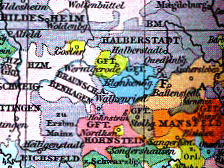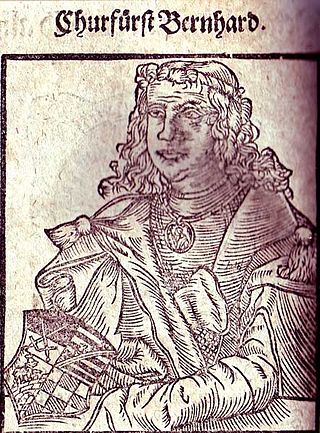
The Derlingau was an early medieval county ( Gau ) of the Duchy of Saxony.

The Derlingau was an early medieval county ( Gau ) of the Duchy of Saxony.
The Derlingau approximately consisted of the area between the river Oker in the west and the Lappwald forest in the east. It was bordered by (from the north, clockwise): Bardengau, Gau Osterwald, Nordthüringgau, Harzgau, Salzgau, Hastfalagau, Gau Flutwide, Gau Gretinge. [1] The most important town was Evessen, and later Brunswick. The Derlingau belonged to the diocese of the Bishop of Halberstadt.
Little is known about the history of the county. The Brunones were its most powerful family in the 10th and 11th centuries; when the Brunones became extinct, their properties were inherited by Lothair of Supplinburg, who became duke of Saxony and later Holy Roman Emperor. From Lothair, Duke Henry the Lion and his descendants, the dukes of Brunswick-Lüneburg, inherited these properties. After the disintegration of the Duchy of Saxony in the early 13th century, the Derlingau thus became a core part of the new Duchy of Brunswick-Lüneburg, together with several adjacent counties.
The northern border of the Derlingau later developed into part of the border between the principalities of Wolfenbüttel and Lüneburg. The eastern and southern border of the Derlingau continues to exist to this day as the border between Lower Saxony and Saxony-Anhalt.
The known counts in the Derlingau include:
As a part of the Diocese of Halberstadt, the Derlingau was subdivided into the following archidiaconates (ordered approximately from north to south):

The Duchy of Saxony was originally the area settled by the Saxons in the late Early Middle Ages, when they were subdued by Charlemagne during the Saxon Wars from 772 and incorporated into the Carolingian Empire (Francia) by 804. Upon the 843 Treaty of Verdun, Saxony was one of the five German stem duchies of East Francia; Duke Henry the Fowler was elected German king in 919.

The House of Welf is a European dynasty that has included many German and British monarchs from the 11th to 20th century and Emperor Ivan VI of Russia in the 18th century. The originally Franconian family from the Meuse-Moselle area was closely related to the imperial family of the Carolingians.

Amelinghausen is a municipality in the district of Lüneburg in Lower Saxony, Germany. It is also the seat of the collective municipality (Samtgemeinde) of Amelinghausen.

Eastphalia is a historical region in northern Germany, encompassing the eastern Gaue (shires) of the historic stem duchy of Saxony, roughly confined by the River Leine in the west and the Elbe and Saale in the east. The territory corresponds with modern southeastern Lower Saxony, western Saxony-Anhalt, and northern Thuringia. Together with Westphalia, central Angria, and Nordalbingia, it was one of the four main Saxon administrative regions.

The Diocese of Halberstadt was a Roman Catholic diocese from 804 until 1648. From 1180, the bishops or administrators of Halberstadt ruled a state within the Holy Roman Empire, the prince-bishopric of Halberstadt. The diocesan seat and secular capital was Halberstadt in present-day Saxony-Anhalt.
The Brunonids were a Saxon noble family in the 10th and 11th centuries, who owned property in Eastphalia and Frisia.

Richenza of Northeim was Duchess of Saxony from 1106, Queen of Germany from 1125 and Holy Roman Empress from 1133 as the wife of Lothair of Supplinburg.
Egbert II was Count of Brunswick and Margrave of Meissen. He was the eldest son of the Margrave Egbert I of the Brunonen family.

The Principality of Anhalt was a State of the Holy Roman Empire, located in Central Germany, in what is today part of the federal state of Saxony-Anhalt.
Lothair I was Margrave of the Nordmark from about 983 until his death. He was also a member of Saxon nobility as Count of Derlingau and of Nordthüringgau.

The County of Blankenburg was a state of the Holy Roman Empire. Its capital was Blankenburg, it was located in and near the Harz mountains.

Liudolf of Brunswick was Margrave of Frisia, Count of Brunswick, Count in the Derlingau and the Gudingau.
Brun, was Count in the Derlingau, the Nordthüringgau, the Hastfalagau, the Salzgau, the Gau Gretinge, and the Gau Mulbeze, with Brunswick as his residence. Brun was a member of the Brunones dynasty.

Bernhard, a member of the House of Ascania, was Count of Anhalt and Ballenstedt, and Lord of Bernburg through his paternal inheritance. From 1180 he was also Duke of Saxony.
The Bardengau was a medieval county (Gau) in the Duchy of Saxony. Its main town was Bardowick; other important towns were Lüneburg and Oldenstadt.

The Harzgau was a medieval shire (Gau) in the northeastern foorhils of the Harz mountains, part of the Eastphalia region of Saxony.

The Nordthüringgau was a medieval county in the Eastphalian region of the German stem duchy of Saxony.
The County of Brunswick was a county in the medieval Duchy of Saxony. It existed from about the 9th century until 1235, when it was raised to a duchy, the Duchy of Brunswick-Lüneburg.

The Schwabengau was an early medieval shire (Gau) in the Eastphalia region of the medieval Duchy of Saxony. Ruled by the House of Ascania, it became the nucleus of the later Principality of Anhalt, today part of the German state of Saxony-Anhalt.
Helperich (Helferich), Count of Plötzkau and Walbeck, and Margrave of the Nordmark, son of Dietrich, Count of Plötzkau, and Mathilde von Walbeck, daughter of Conrad, Count of Walbeck, and Adelheid of Bavaria. The count's sister Irmgard was married to Lothair Udo III, Margrave of the Nordmark, and was the mother of Helperich's successor in ruling the margraviate, Henry II.